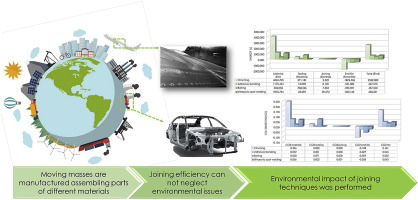Journal of Cleaner Production ( IF 9.7 ) Pub Date : 2019-04-26 , DOI: 10.1016/j.jclepro.2019.04.339 Francesco Gagliardi , Domenico Palaia , Giuseppina Ambrogio

|
The industrial production must be driven forward by a leading idea, which aspires to prevent pollution and to reduce the carbon emissions. A greener future is motivating the technological progresses. The key word is sustainability protecting the environment of the future by low impact solutions.
In manufacturing, this has been resulting in process optimization to guarantee the quality and safety standards of the parts exhibiting an as low as possible environmental impact. The introduction of new materials and their combination is one of the strategies that has been pursued. In this context, the joints between dissimilar parts are important affecting the weight, the mechanical properties and the production costs of the manufactured structures.
In the proposed research, the primary joining categories (i.e. mechanical, thermal and chemical processes) have been analysed assessing their environmental consequences in the engineering of hybrid structures. Specifically, components manufactured by the combination of polymer matrix composites (PMC) and metals (lightweight alloys) are the analysed hybrid solutions. These result in a weight saving without being forced to reduce the performances or to increase the production costs of the parts. Joining solutions that can connect PMC and lightweight alloys have been, therefore, considered in the performed comparison. The energy consumption and CO2 emissions of the investigated processes, being equal the bearing strength for each of them, have shown a better environmental impact of the mechanical fastening performed by bolts. Currently, this is the only solution, which allows part disassembling. However, the recycling of hybrid components is a new requirement and new dismantling strategies can be developed. For this reason, the study has been extended taking the components down for whatever investigated joining solution. Hence, adhesive bonding and ultrasonic spot welding become environmentally-friendly as well.
中文翻译:

制造混合结构的连接过程的能耗和CO 2排放
工业生产必须以领先的理念推动,该理念旨在防止污染并减少碳排放。更绿色的未来正在推动技术进步。关键词是可持续发展,通过低影响的解决方案保护未来的环境。
在制造过程中,这导致了过程优化,以确保零件的质量和安全标准对环境的影响尽可能小。引入新材料及其组合是一直追求的策略之一。在这种情况下,不同零件之间的接合处对重量,机械性能和制造结构的生产成本至关重要。
在拟议的研究中,已经分析了主要的连接类别(即机械,热和化学过程),以评估它们在混合结构工程中的环境后果。具体而言,由聚合物基复合材料(PMC)和金属(轻质合金)的组合制造的组件是被分析的混合溶液。这些导致重量减轻,而不会被迫降低性能或增加零件的生产成本。因此,在进行的比较中考虑了可以连接PMC和轻质合金的连接解决方案。能源消耗和CO 2所研究过程的废气排放(等于每个过程的轴承强度)显示了由螺栓执行的机械紧固对环境产生的更好影响。当前,这是唯一允许零件拆卸的解决方案。但是,混合组件的回收是一项新的要求,并且可以开发新的拆卸策略。由于这个原因,该研究已扩展到将所研究的联接解决方案的组件拆下来。因此,粘合剂粘结和超声点焊也变得环保。











































 京公网安备 11010802027423号
京公网安备 11010802027423号